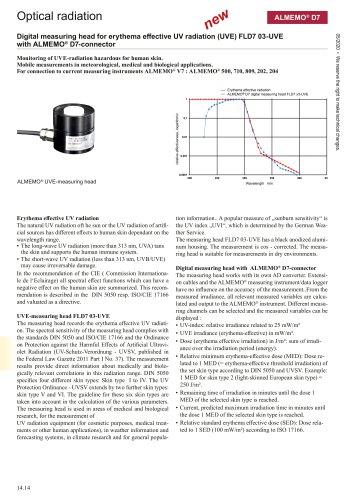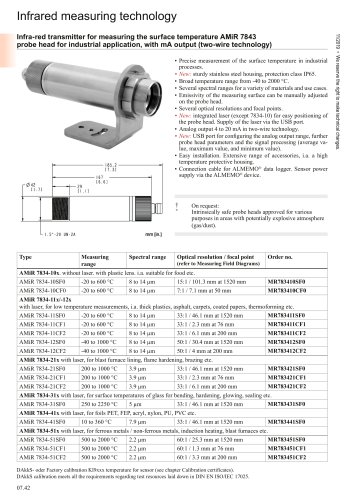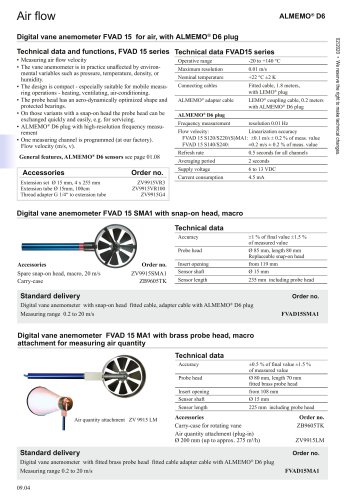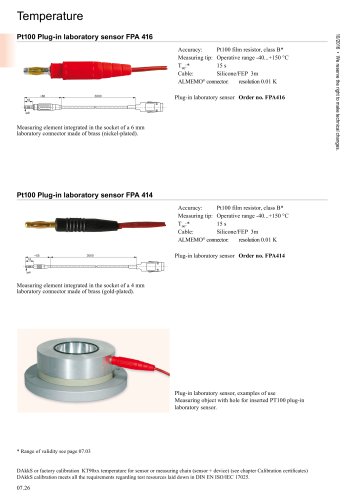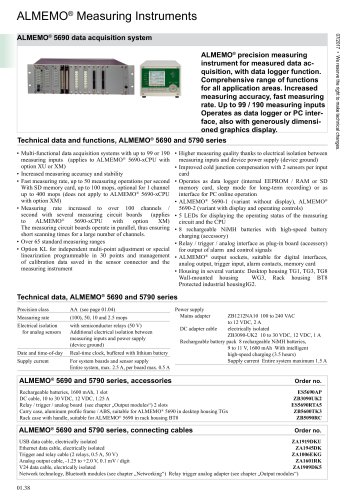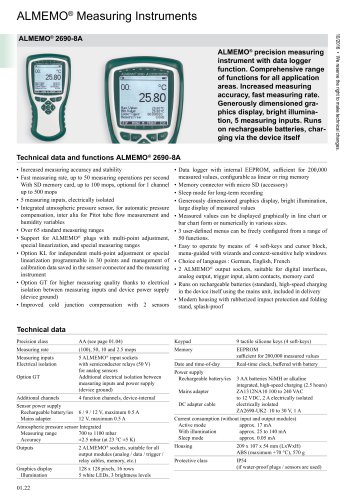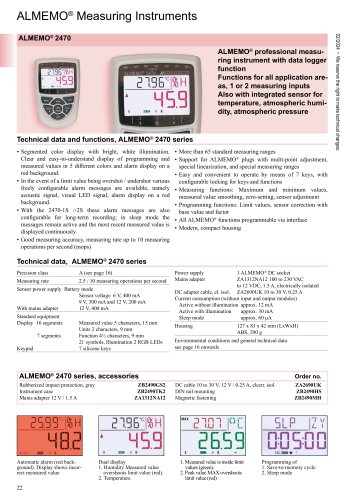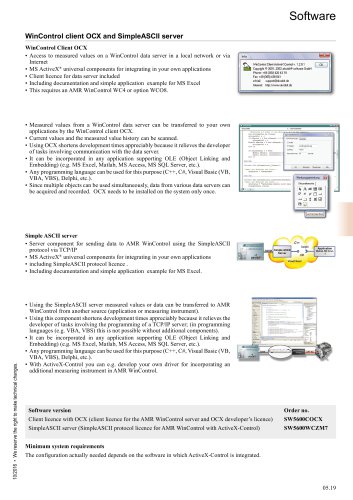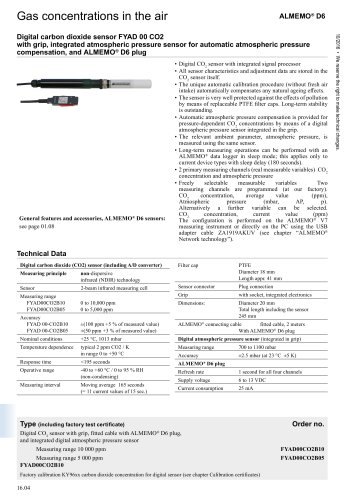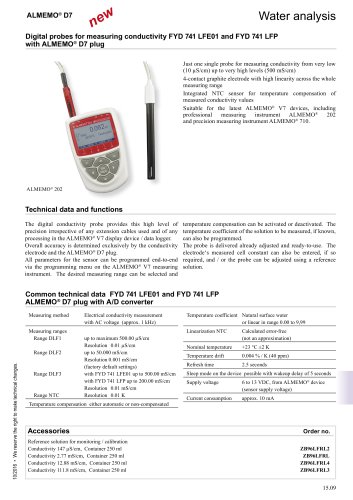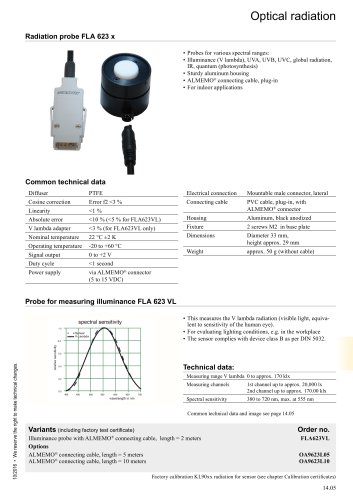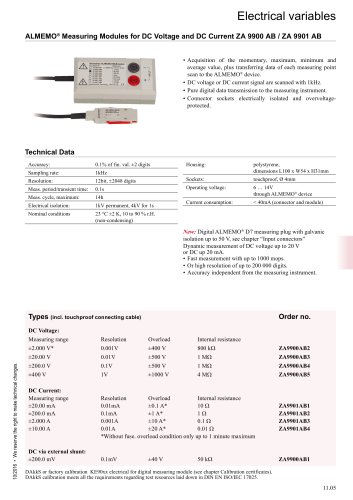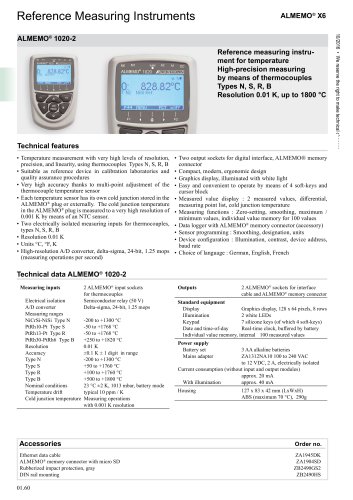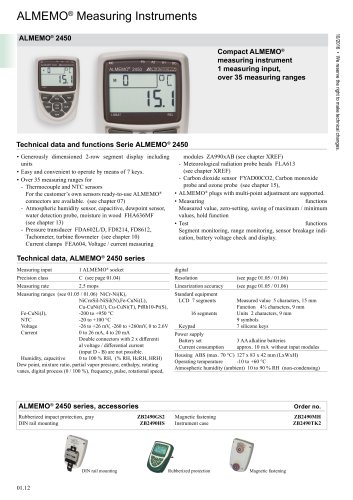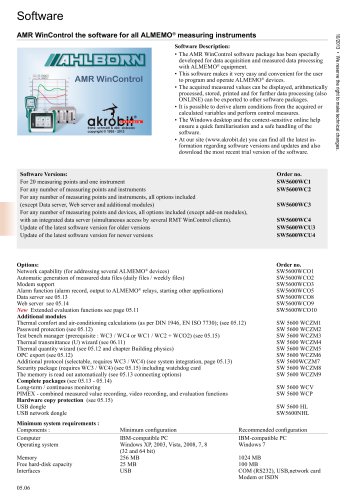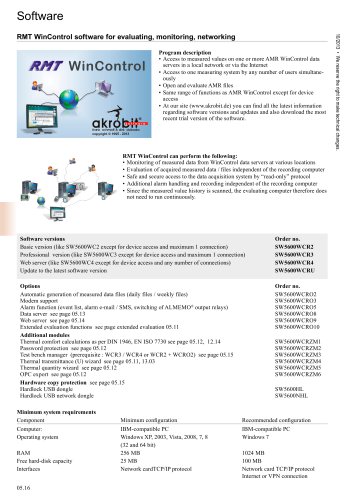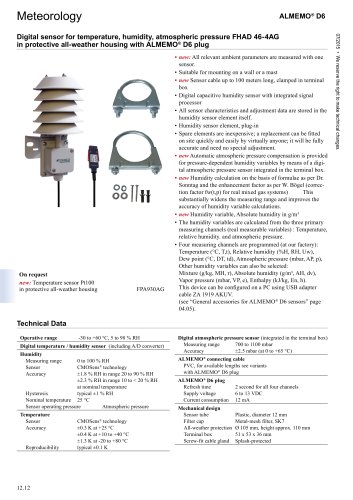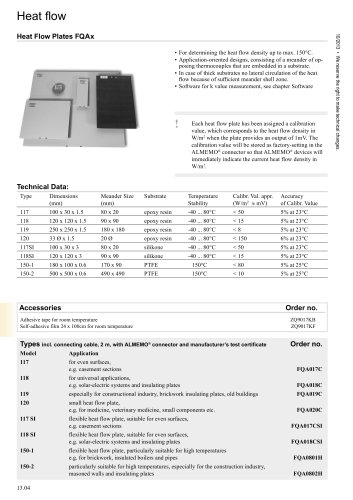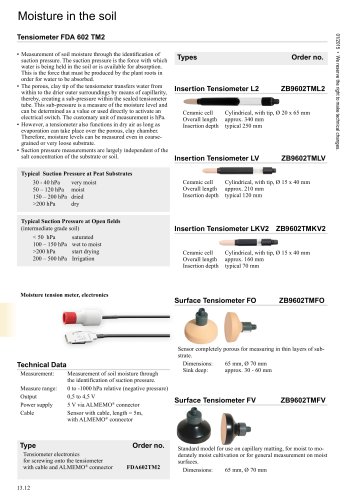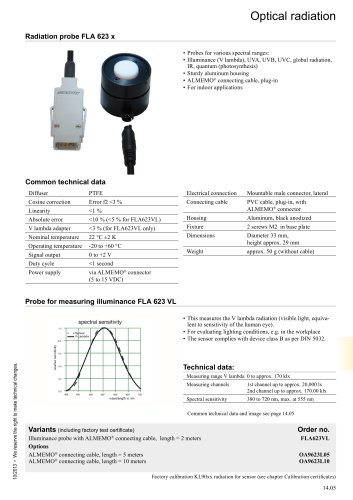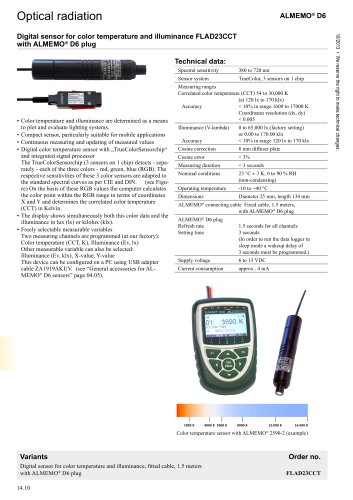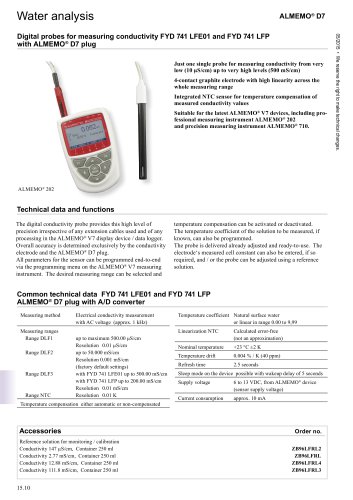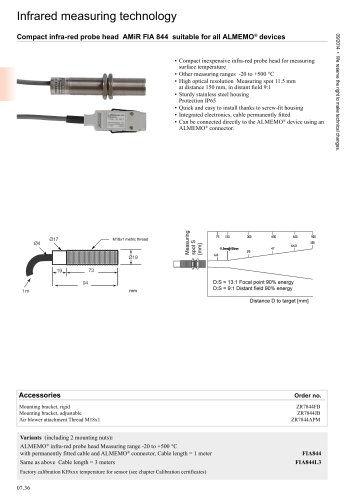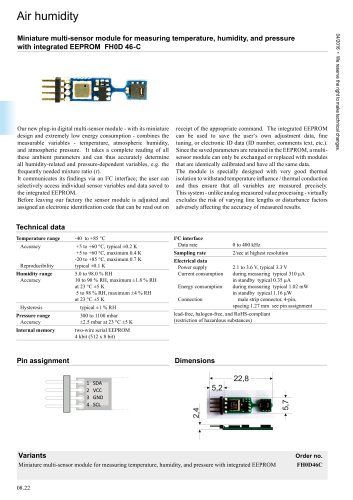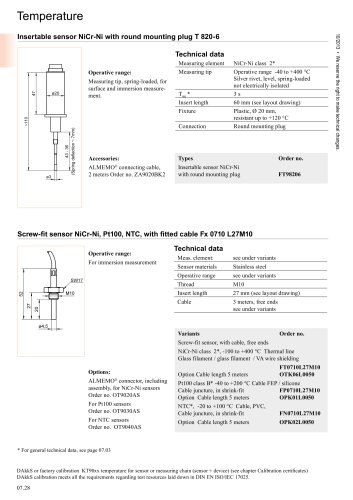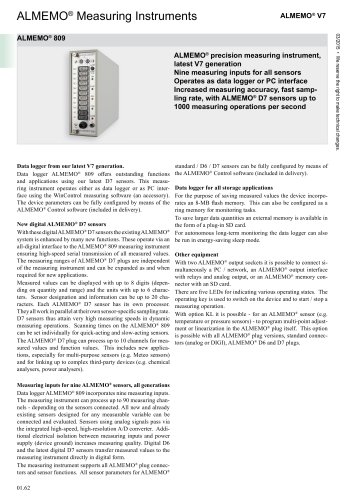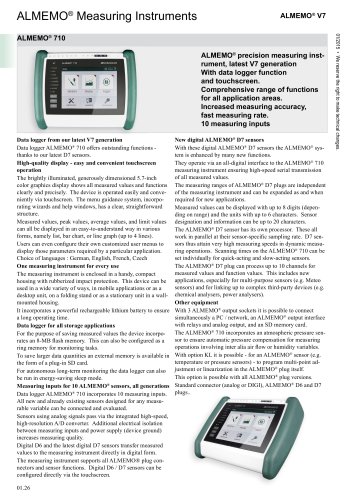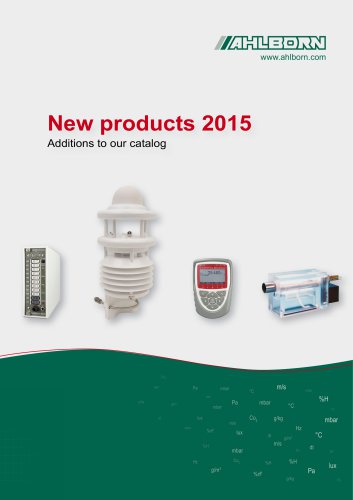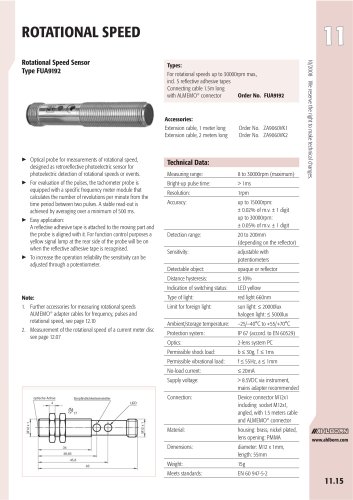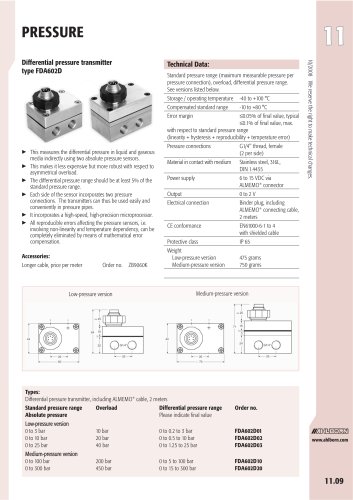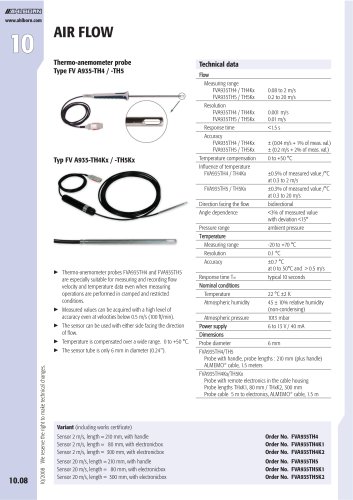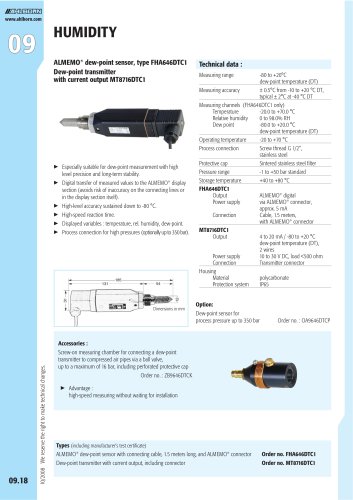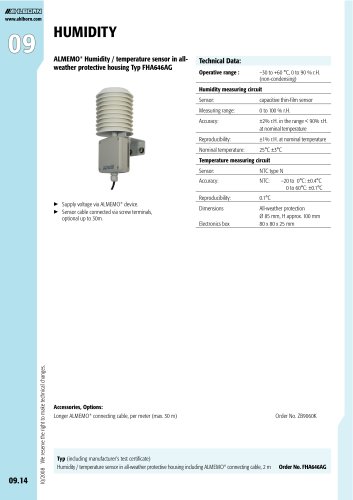Catalog excerpts

An unsatisfactory room air quality of indoor rooms (e.g. in offices) can easily cause tiredness, poor powers of concentration and even diseases to people. Indicator for the room air quality is the concentration of specific gases in air. The most important ones include: Carbon dioxide (CO > 2 ) Carbon monoxide (CO) Oxygen (O > 2 ) Ozone (O > 3 ) CO > 2 Concentration An important criterion for the evaluation of the room air quality is the CO > 2 concentration. A CO > 2 concentration, which is too high due toinsufficient ventilation, is experienced as stale or stagnant air. The illustration above shows the range of CO > 2 concentrations that arerelevant to a human. CO Concentration CO is produced when carbon is only partially combusted (fuel). CO is very dangerous for humans because it is at the same time highlytoxic - and invisible and odorless. Reasons for the production of CO in various combustion processes : deficiency of air too high excess of air too early cooling down of flame Effects of CO in the ambient air on the human bodyCO concentration Inhalation period and consequences 30 ppm 0.0003% Maximum concentration in the workplace per 8-hour shift (German MAK value) 200 ppm 0.02% Slight headache within 2 to 3 hours 400 ppm0.04% Headache within 1 to 2 hours, first in the forehead and temples, then spreading to the whole head 800 ppm0.08% Dizziness, nausea, and twitching limbs within 45 minutes, unconsciousness within 2 hours 1600 ppm0.16% Headache, dizziness, nausea within 20 minutes, death within 2 hours 3200 ppm0.32%Headache, dizziness, nausea within 5 to 10 minutes, death within 30 minutes 6400 ppm0.64%Headache and dizziness within 1 to 2 minutes, death within 10 to 15 minutes 12800 ppm1.28% Death within 1 to 3 minutes Applications measurement, control, and warning system in garages, monitoring of room air quality with respect to maximum permissible workplace concentration (MAK value) monitoring of outside air or of protected air systems in domestic and large public shelters > 01/2007 We reserve the right to make technical changes. size="-3">
Open the catalog to page 1
01/2007 We reserve the right to make technical changes. O > 2 Concentration > The inhaled air consists of vital oxygen at a ratio of 1:5. Oxygen is required for all oxidation processes; for combustion processes, aswell as for silent oxidations. Examples include the rusting of iron, oxidations, which occur in living processes, or the decomposition oforganic material. Additionally, all combustion processes that release energy require this gas, for example, heating systems or aircraftengines. However, oxygen is also bound with any type of noxious fires such as forest and heath fires. Due to...
Open the catalog to page 2
Sensor:2-channel infra-red absorption principle Measuring range:0 to10 000 ppm (0 to 1 vol% CO > 2 )Accuracy:0 to 5000 ppm(under nominal conditions)(50 ppm+ 2% of measured value)5000 to 10000 ppm Compact sensor for mobile and stationary applications. ѱ(100 ppm +3% of meas. value) High display resolution (1 ppm). Resolution:1 ppm or 0,0001 vol % Nominal conditions:22C б2 C / 50 % rF б 10 % rF > Ambient temperaturer:0 to +50 C Operation with the device in SLEEP mode is not possible!When operating more than one CO > 2 probe on a singleALMEMO Storage temperature:-20 to +50 аC > device, these CO...
Open the catalog to page 3
01/2007 We reserve the right to make technical changes. Gas:CO Measuring principle:electrochemical reactionMeasuring range:0 150 ppm, 0 Ņ 300 ppm, 0 5% Zero point error:< 10 ppm CO Particularly suitable for long-term measurements of thecarbon monoxide concentration in air, in a range from 0 Ņ 150ppm to 0 5vol%. Gauge reading balance:< 3 ppm CO Error of meas. value:ű3% of full scale value Applications:For measurement, control and warnings in garages, for monitoring the air quality with respect to the maximum allowable concentration at work places (MAC value, e.g. in laboratories and engine...
Open the catalog to page 4
Gas:O > 3 (ozone)Measuring principle:electrochemical three-electrode sensor Measuring range:0 300 ppb Detection limit 20 ppb Accuracy:typically 5% of final value undernominal conditions (for intermittent operation)Long term accuracy:after 12 months under nominalconditions typically5% of final value (for intermittent operation)Exposure period : until specification is reached, atleast 2 hours (at 200 ppb); for a prolonged period the device was Each ozone sensor is supplied with a calibration certificate. Suitable for many measuring tasks where ozonemeasurements for control purposes were too...
Open the catalog to page 5
01/2007 We reserve the right to make technical changes. The sensors used for measuring gas concentration in air - at a glance with measuring instrument ALMEMO >
Open the catalog to page 6All Ahlborn Mess- und Regelungstechnik GmbH catalogs and technical brochures
-
Measuring instruments and sensors
372 Pages
-
Product Catalog
348 Pages
-
FPAD 36-3
2 Pages
-
Electrical variables
2 Pages
-
FLD7 33-UVE
2 Pages
-
Optical radiation ALMEMO® D7
2 Pages
-
FHAD 46-DTC2
1 Pages
-
ALMEMO® 2490-1L
1 Pages
-
ALMEMO® 204
3 Pages
-
AMiR 7834
6 Pages
-
ALMEMO® D6
1 Pages
-
ALMEMO® 470-1
4 Pages
-
ALMEMO® 1033-2
1 Pages
-
MH8D46
2 Pages
-
FHAD46-7
1 Pages
-
FHA 646 R
1 Pages
-
Connector for thermocouples
1 Pages
-
Glass thermometer
1 Pages
-
Pt100 cable sensor
1 Pages
-
Thermo-wires
3 Pages
-
ALMEMO® 1030
2 Pages
-
ALMEMO® 8590 / 8690
2 Pages
-
ALMEMO® 5690
10 Pages
-
ALMEMO® 2890
2 Pages
-
ALMEMO® 2690
2 Pages
-
ALMEMO® 2590
3 Pages
-
ALMEMO® 2470
3 Pages
-
ALMEMO ® 8036
3 Pages
-
ALMEMO ® 500
3 Pages
-
Product Catalog
329 Pages
-
D6 connectors
1 Pages
-
OCX Win Control
1 Pages
-
ALMEMO® Control
4 Pages
-
CO2 sensor
2 Pages
-
conductivity D7
2 Pages
-
FLA623
3 Pages
-
Comfort Index
2 Pages
-
Modules for DC
1 Pages
-
Pressure sensors FDA602L
1 Pages
-
D6 Anemometer
1 Pages
-
Pitot Tubes
2 Pages
-
Digital sensor for humidity
3 Pages
-
FHAD 36 Rx
4 Pages
-
ALMEMO® 1036
2 Pages
-
ALMEMO® 1020
3 Pages
-
ALMEMO® 2490
2 Pages
-
ALMEMO® 2450
2 Pages
-
General accessories
3 Pages
-
Instrument Cases
1 Pages
-
ALMEMO ® Control : Software
4 Pages
-
Software ALMEMO ® View
1 Pages
-
ALMEMO ® D6
2 Pages
-
Pressure FDAD 12 SA
1 Pages
-
Sound Level MA 86193
1 Pages
-
FHA 696 GF1
1 Pages
-
Heat Flow Plates FQAx
2 Pages
-
Moisture Sensor FHA 696 MF
4 Pages
-
Radiation probe FLA 623 x
3 Pages
-
FLA 613 VLK
2 Pages
-
FLAD23CCT
2 Pages
-
Sensor FYAD 00 CO2B10
2 Pages
-
Transducer FYA600O3
1 Pages
-
AMiR FIA 844 s
2 Pages
-
AMiR 7838
6 Pages
-
FD 8214
2 Pages
-
FMD7-60
3 Pages
-
EEPROM FH0D 46- C
1 Pages
-
T 820-6
2 Pages
-
ALMEMO ® 202
2 Pages
-
ALMEMO 2490
2 Pages
-
ALMEMO ® 2470
3 Pages
-
ALMEMO ® 2690-8A
2 Pages
-
ALMEMO ® 5690
10 Pages
-
ALMEMO ® 1030-2
1 Pages
-
ALMEMO ® 1036-2
2 Pages
-
ALMEMO transmiter 2450/2490
2 Pages
-
ALMEMO ® 4390-2
1 Pages
-
ALMEMO ® 809
2 Pages
-
ALMEMO ®
3 Pages
Archived catalogs
-
Infrared Measuring Technique
24 Pages
-
Water Analysis
8 Pages








